Rare astronomical events have the ability to make people more aware of the details while also considering the bigger picture.
Things like solar eclipses, meteor showers, or dancing aurora can have an effect on a person’s psyche that creates a deeper understanding of our place in the universe. Watching the moon blot out the sun for a few minutes (as it did across the U.S. on August 21, 2017) could be a transformative experience that makes one appreciate the little moments a bit more.
When I gazed skyward to witness my first total solar eclipse, I was struck by how much I was unprepared for what I was about to experience. Every moment of the one minute and forty-four seconds of totality passed by in what I would call thick and creeping time. My experience of this time dilation was familiar to other unique moments in life where I seem to exist outside of time, however briefly, and get a glimpse of something perpetually hard to explain but extremely real to my being.
Just like extreme sports, moments with a loved one, or near-death experiences, powerful events have a power to bring you into the current moment where past and future have no real meaning: there is only, and will ever only be, now. Of course, when the sun reappeared and the eclipse was only a memory, time sped up and my past and future rushed in to fill the cracks and occupy my mind.
But for just a few moments, I truly was.
Strangely enough, I sometimes find little existential moments like these when I gaze into incredible mechanics and complex machines that defy expectations and provide an escape for an energetic mind. When those mechanics exist to convey the wonders of the universe, it’s even better.
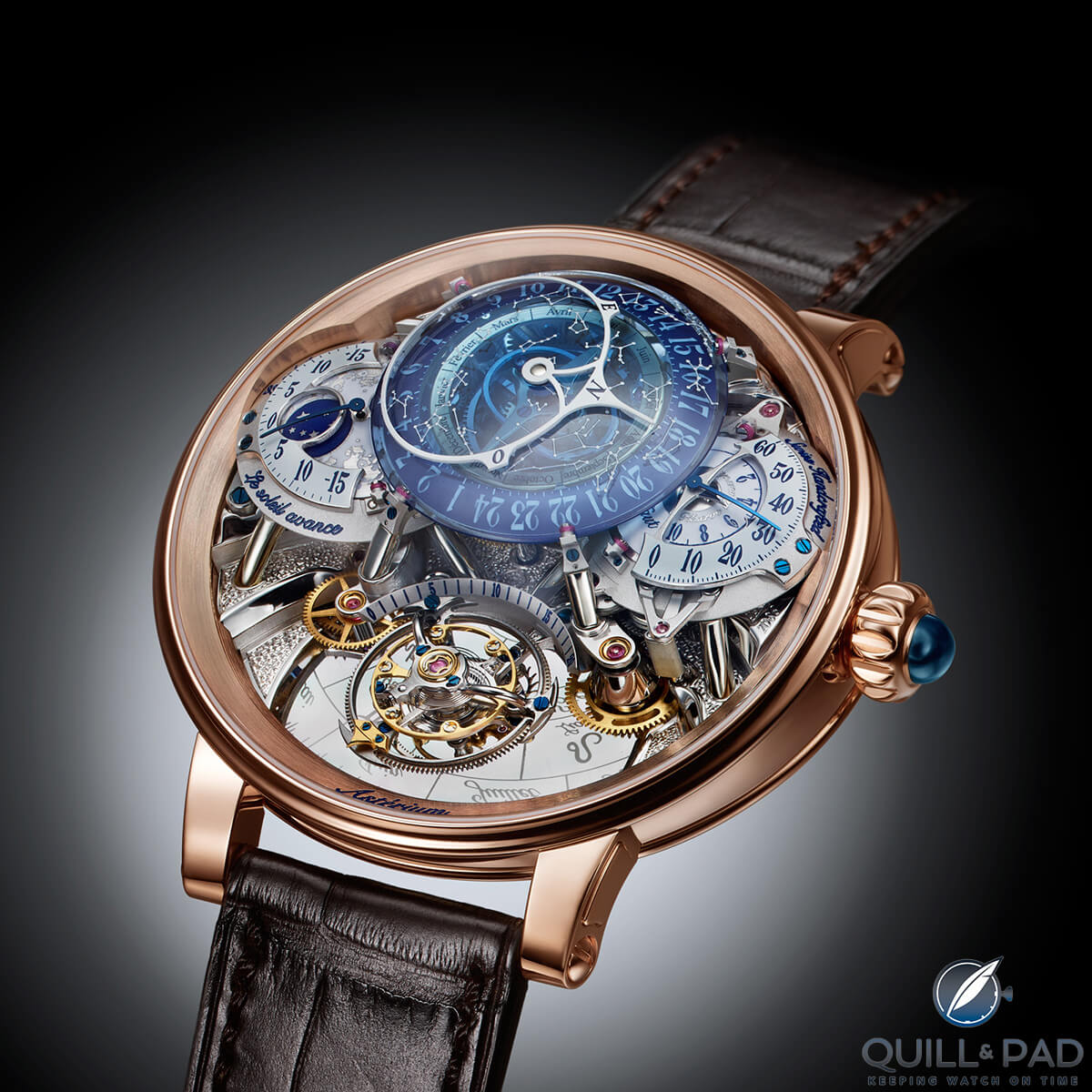
Bovet Récital 20 Astérium
In January 2017, Bovet announced a new piece that got me excited, and when I finally saw it in the metal it gave me one of those brief moments of escape from the unrelenting march of time. That piece is the Récital 20 Astérium and it combines a variety of unique and novel creations that give you plenty to think about.
Thoughts on time
The Bovet Récital 20 Astérium is one serious watch with a variety of astronomical indications that you may have seen before, but never like this.
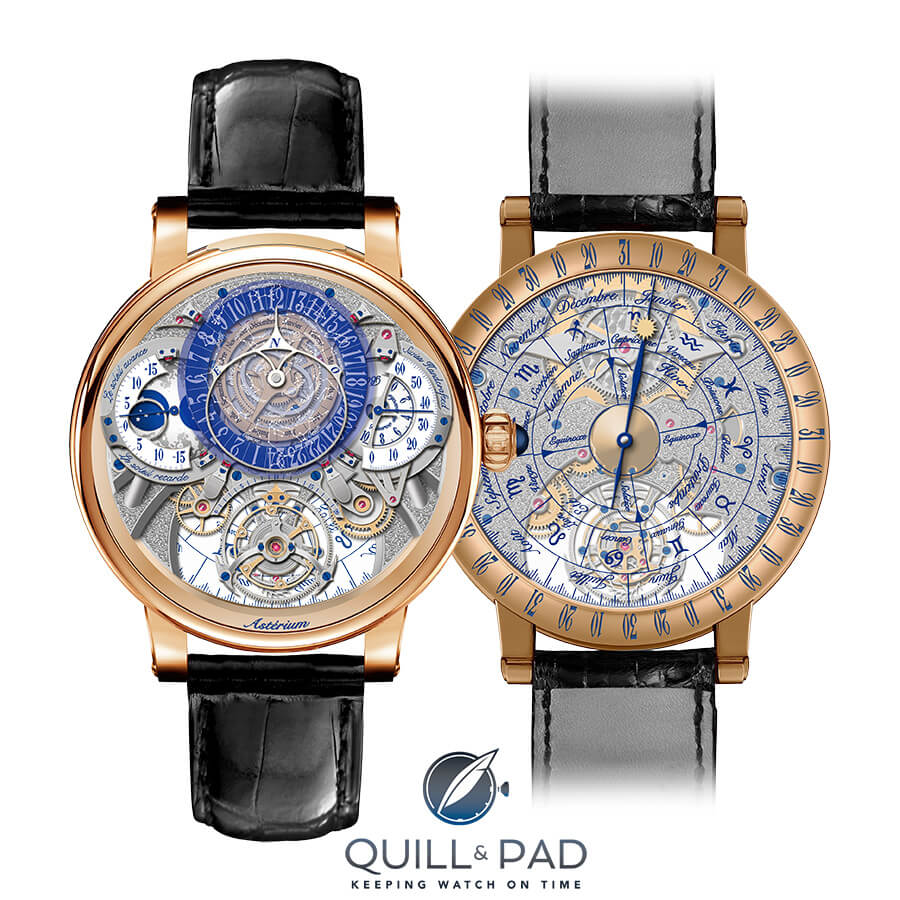
Front and back views of the Bovet Récital 20 Astérium
The Astérium also features a unique take on the calendar that, actually, is focused more on consistent accuracy than easily averaged accuracy like nearly every other calendar out there.
The Astérium and many of its indications are driven by the annual calendar, which is kind of a misnomer. This calendar follows the sidereal year, which is the length of time it takes for earth to complete one revolution of its orbit as measured against a fixed frame of reference (such as the fixed stars rather than just our sun).
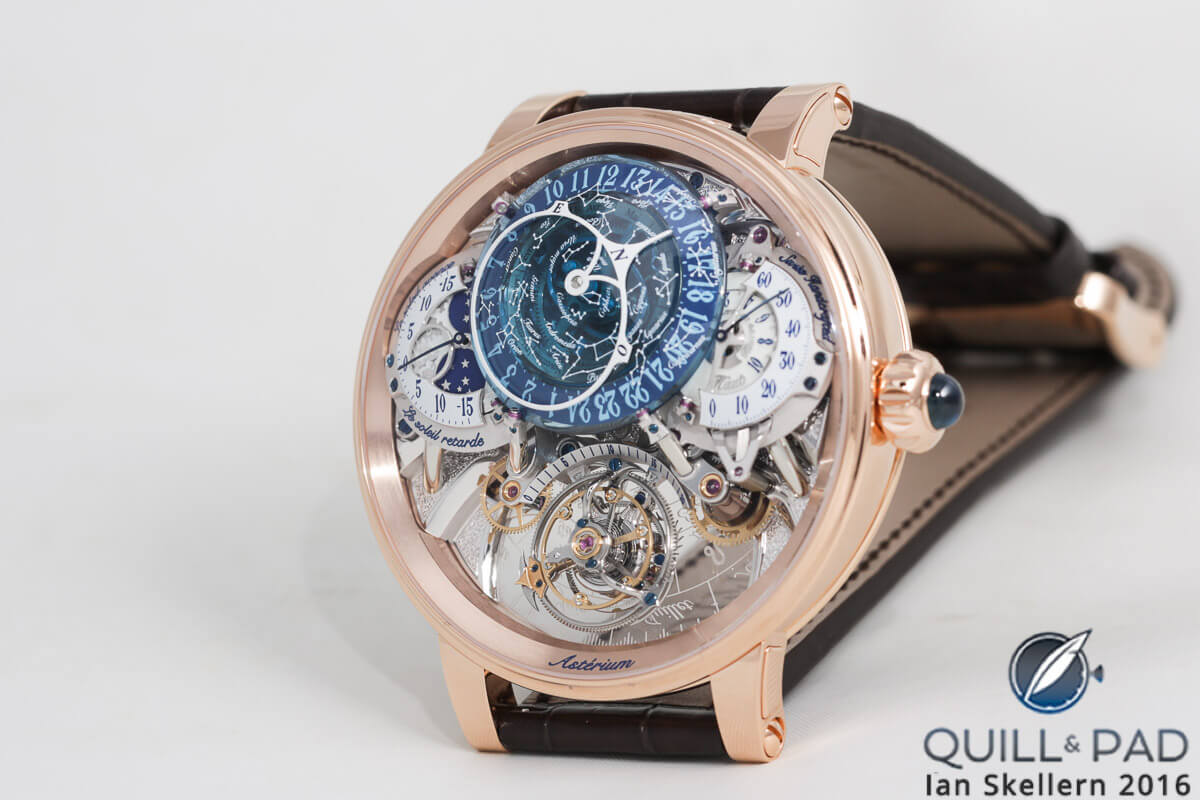
Bovet Récital 20 Astérium
This is an averaged calculation – earth’s orbit always varies due to a host of factors – that comes out to 365.256363004 days, which is usually averaged again to 365.25 days for ease of use.
The annual calendar in the Astérium (a sidereal calendar as explained above) uses this averaged 365.25 number to keep the astronomical indications accurate every year without the quarter-day drift of perpetual calendars (which only catch up every four years). With this more constant accuracy, the indications stay accurate to the celestial motions for 158 years before needing to be adjusted by one day, kind of like the slow mechanical moon phase drift.
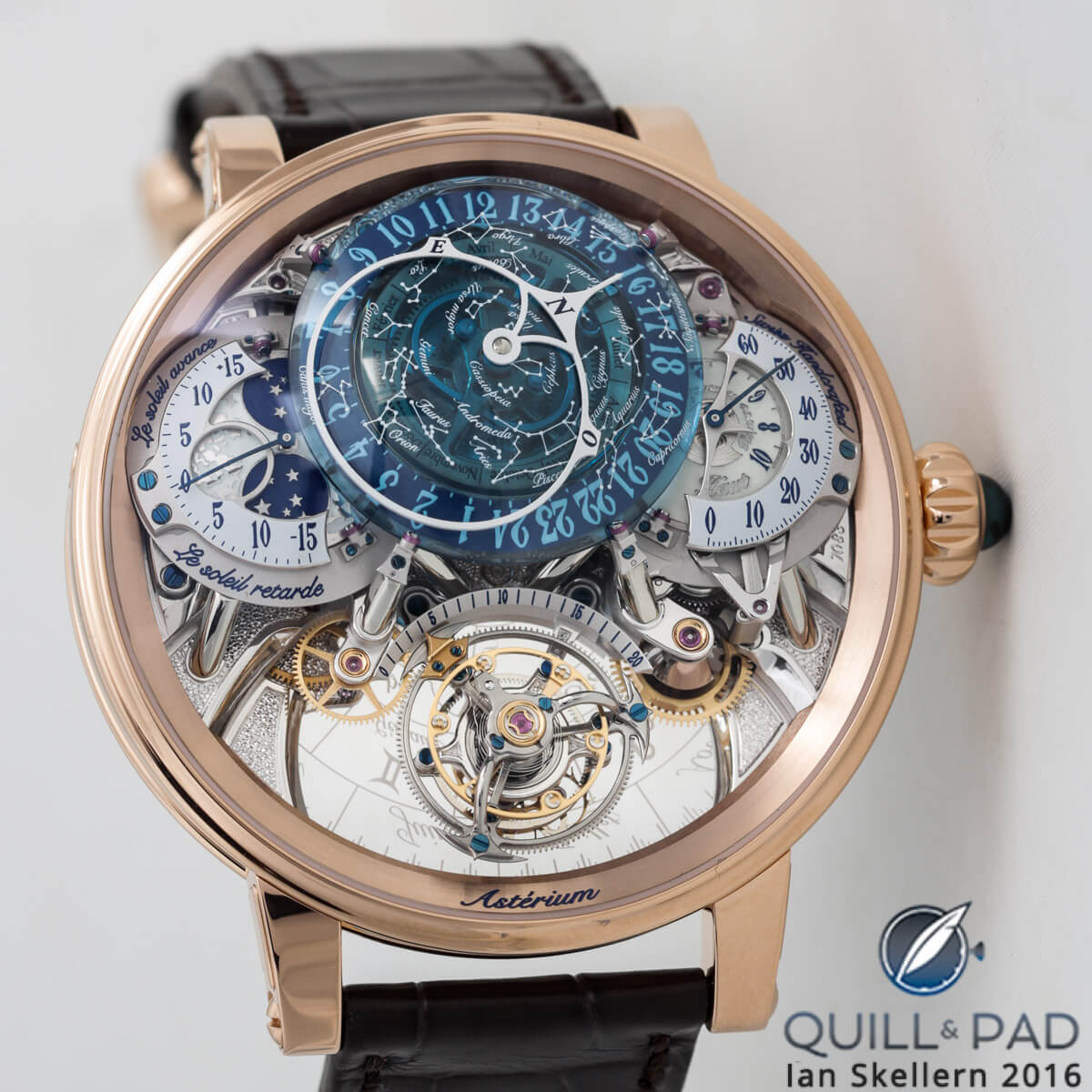
Bovet Récital 20 Astérium
The remainders on the average time, the numbers after 365.25 . . . 6363004, account for the slow buildup of error that eventually needs correcting. The adjustments of the Gregorian calendar, which is based on the 365.24219 solar year (aka tropical year), eventually make up for its cumulative error with leap years (and occasional skipped leap years).
Though the difference is very minor, the Astérium’s calendar is basically detached from our civil Gregorian-based calendar so as to display a more accurate celestial position until the Gregorian calendar catches up every four years,. But it shows that the desire for Bovet was to chart the sky more accurately and thus indicate what is really going on up there.
Displays of the universe
Which leads to what all the astronomical indications are, and there are many.
On the rear of the case you find the actual annual calendar indication, a rotating hand with an image of the sun as the hand takes one full year to make a full revolution indicating earth’s trip around the sun. The days are listed on the case back bezel, while the months are etched onto the rear sapphire crystal.
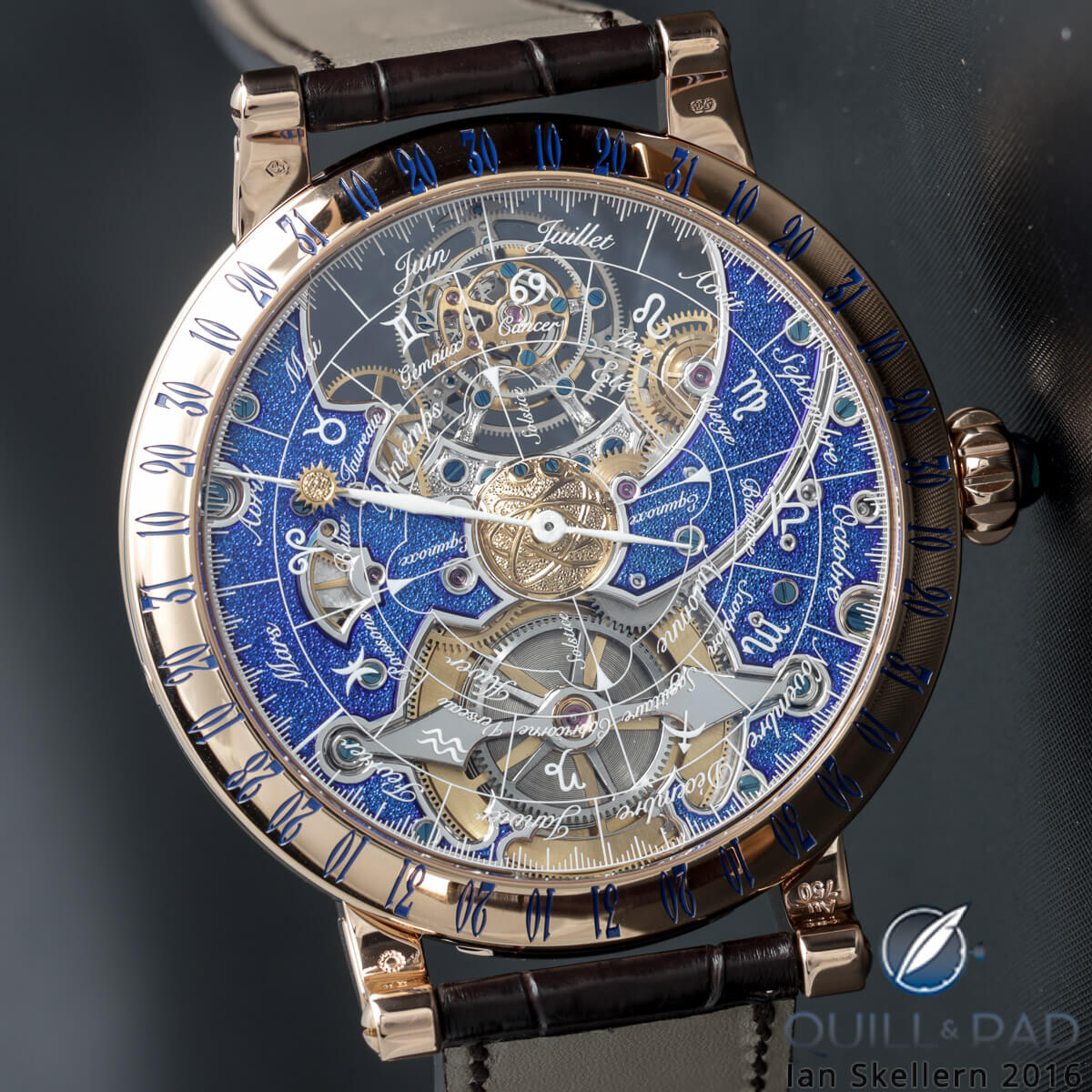
The astronomical back of the Bovet Récital 20 Astérium
Inside the ring of the months is the zodiac calendar, which is shown with the sun on the indicator as it passes through each sign. Moving inward we find the seasons, separated by the equinoxes and solstices. The back of the watch displays a handful of different indications with a single hand, which is the most useful implementation of a calendar I’ve seen. But that isn’t the end.
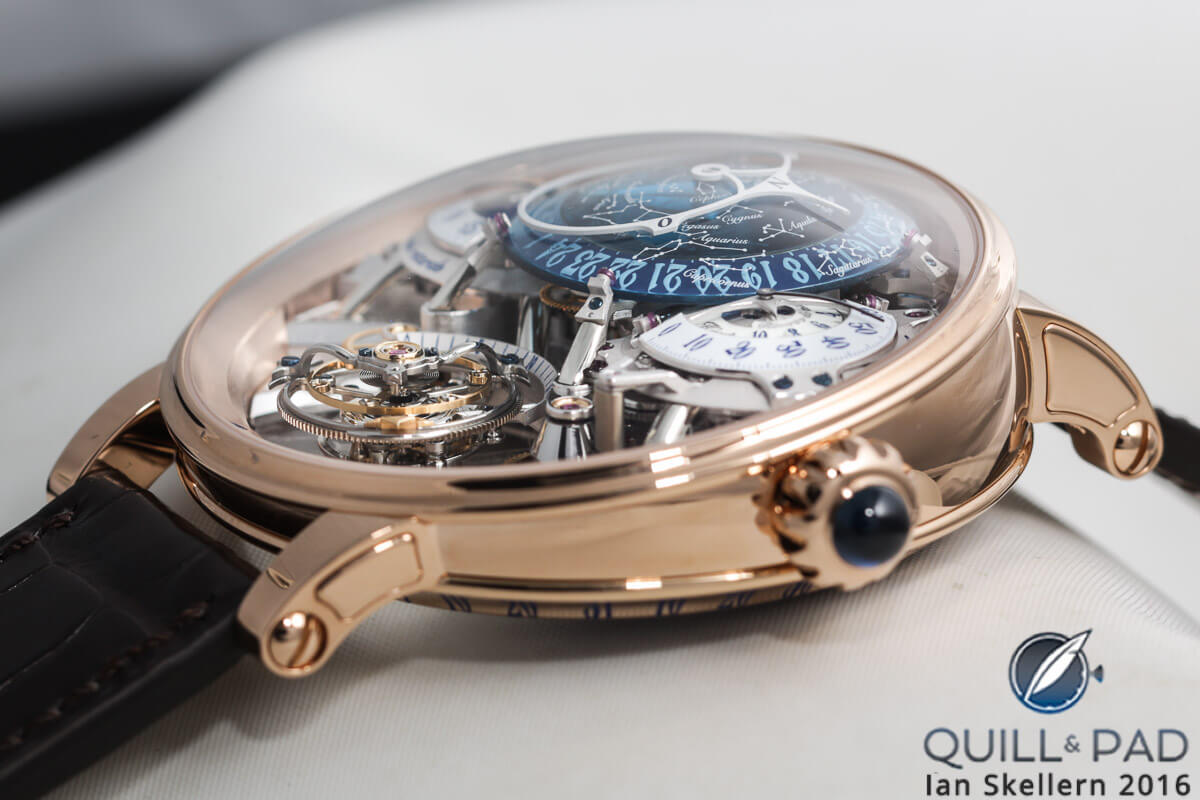
Bovet Récital 20 Astérium
Moving to the front of the watch a grand sight materializes: the night sky. Depending on what whether the northern or southern hemisphere has been selected by the watch’s owner, at 12 o’clock a large domed blue quartz crystal displays the proper set of constellations, which revolve throughout the year to match the view in the night sky. Underneath the quartz dome the hours are etched from 1 to 24 on a disk; a smaller disk with the months is also included. The hours are stationary, but the month disk moves with the sky chart and the hour hand rotates on top.
The hour hand is also the sky chart viewer as it has a large elliptical opening opposite the pointer (marked with an N for “north”) to indicate where the constellations are in the sky at any time and to aid in orientation. Since the hours are indicated to 24, allowing day and night to be differentiated on one scale, this means that the constellations in the sky at the same time every night shift throughout the year to match the motion of constellations as a result of our orbit around the sun. The month disk rotating with the quartz dome shows how the constellations are tied to the monthly position of earth’s orbit around the sun.
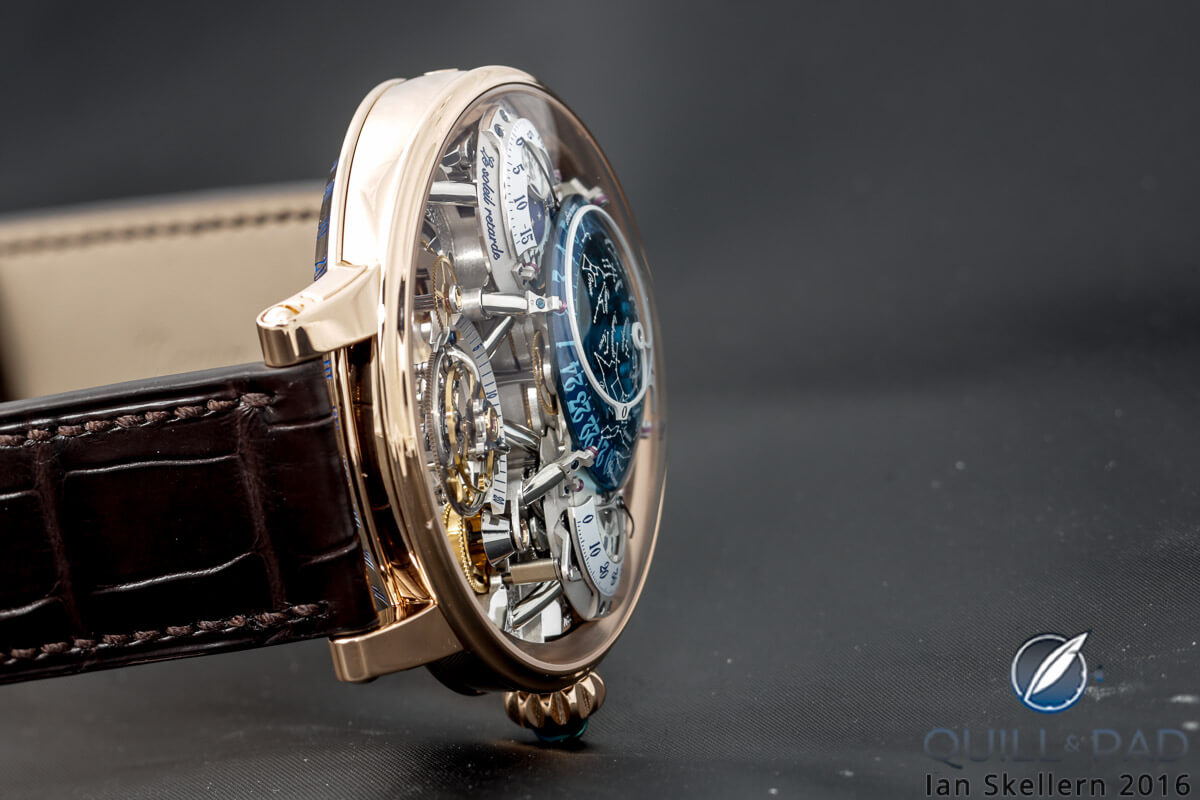
View from between the lugs at 6 o’clock highlighting the wedge-shape of the movement and case of the Bovet Récital 20 Astérium
Packed with more goodness
If these were all the indications on the Récital 20 Astérium, it would be considered a rather epic timepiece. But of course Bovet wasn’t finished yet.
To the left of the sky chart and hour display are located the domed moon phase and the equation of time indication. The moon phase rotates separately from the sky chart and annual calendar since they aren’t relative to each other. The retrograde equation of time indicator is directly linked to the annual calendar and sky chart as they are products of the same motion in the heavens.
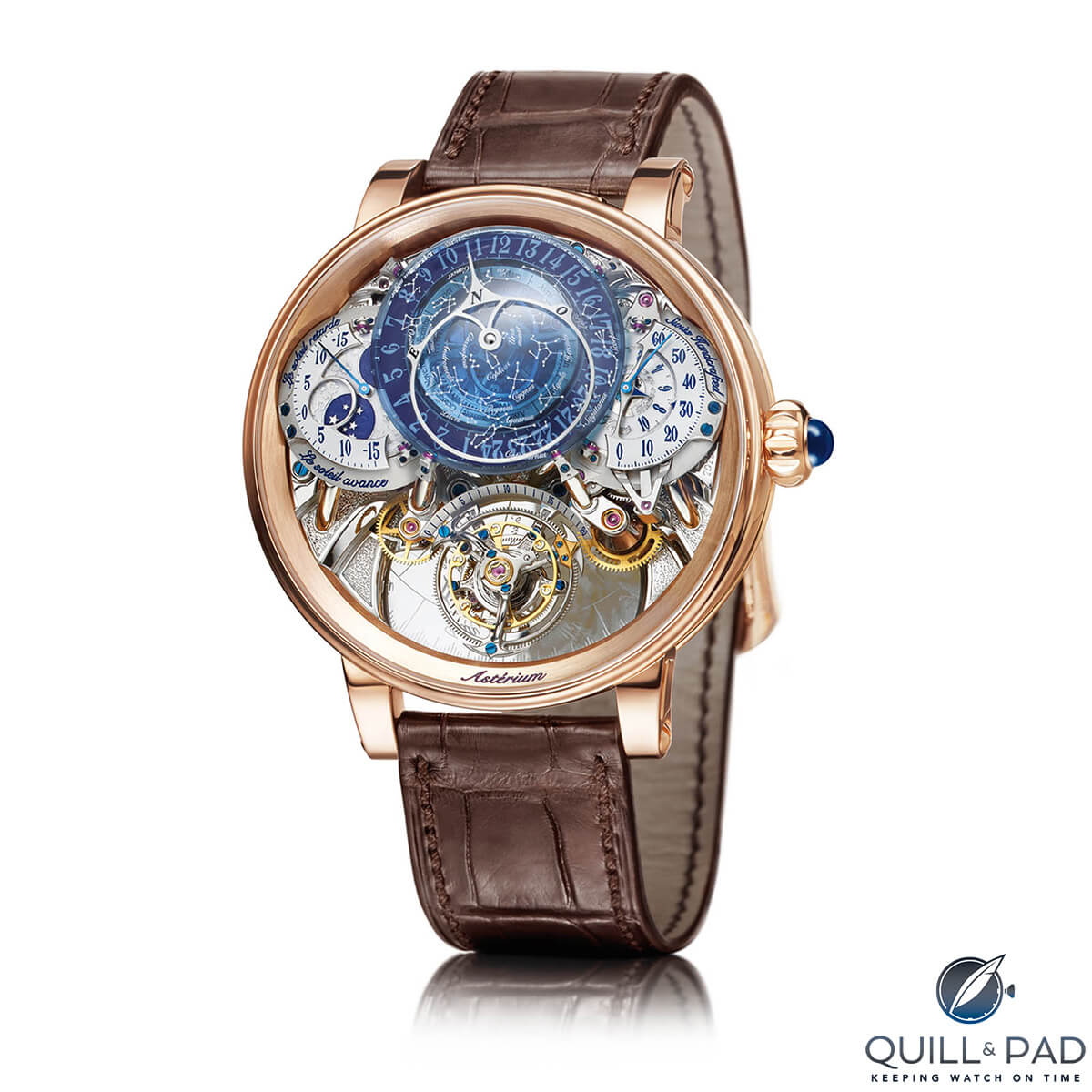
Bovet Récital 20 Astérium in red gold
On the right of the sky chart are the mirrored twins of the moon phase and equation of time, retrograde minutes, and a domed 10-day power reserve indicator. The minutes are on top with the dome underneath, just like on the opposite side.
And here, too, the dome rotates on something very special.
The three domes are rotated from their centers, but supported on the periphery via a set of perpendicular ruby rollers. These were first introduced on the Récital 18 Shooting Star, and their return is a most welcome sight as these may be one of my favorite aspects of the movement construction since they are so uniquely suited to this layout – a layout that also results in some very incredible choices for layer construction.
Numerous arched pillars support various plates and bridges leading to a dramatic three-dimensional assembly, with the movement operating on what must be more than a dozen different levels. The sheer height of the assembly could be daunting if not done in an extra-clever way.
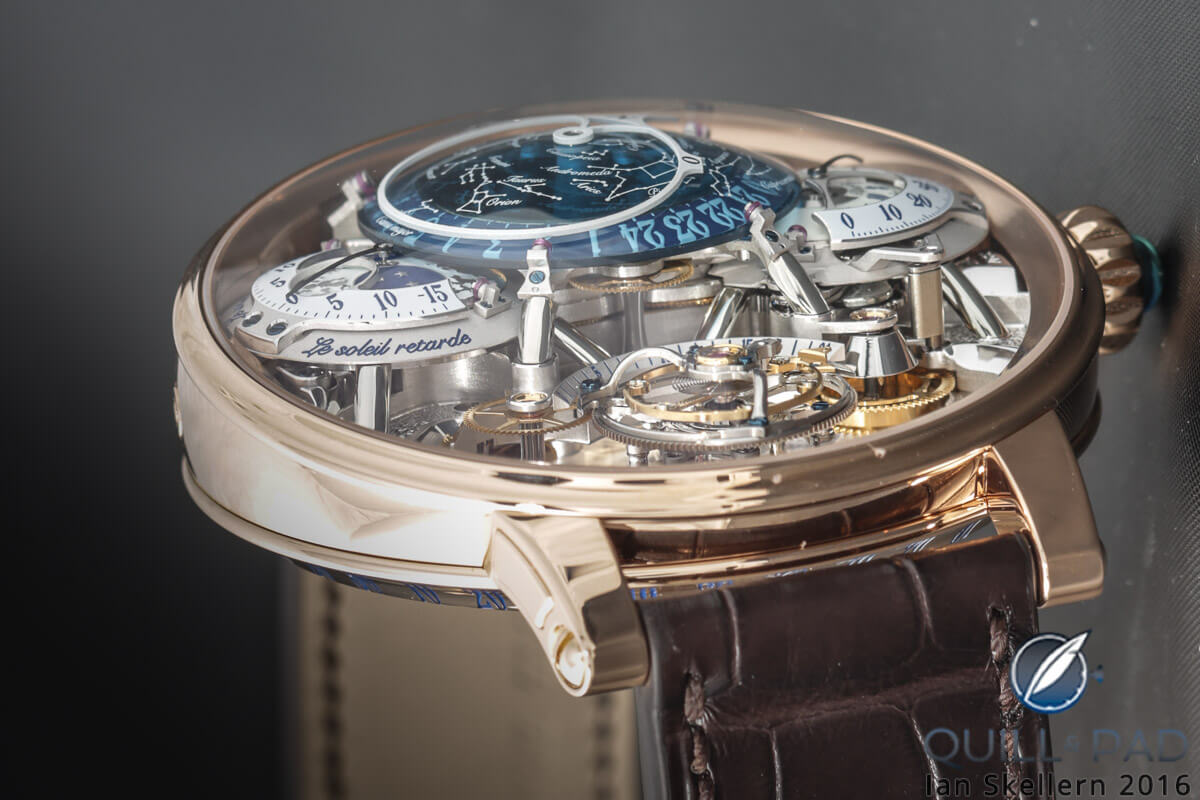
Side-on view of the flying tourbillon of the Bovet Récital 20 Astérium
Since only a portion of the movement is high, it takes on a wedge shape that is shorter on the bottom at 6 o’clock and thicker on the top at 12 o’clock. To make sure the Récital 20 Astérium was as wearable as possible, the shape of the case follows the form of the wedge-shaped movement, which makes reading the tilted dial even easier.
Not only does this make the watch seem more like a showpiece, but the sloping case emphasizes the last major component I have yet to mention: the double-face flying tourbillon mounted in the center of its assembly, allowing the observer to see the mechanism moving without a bridge interfering.
Bovet does this type of tourbillon support so well that it always looks like the tourbillon is truly floating beyond the movement. And, as the balance oscillates at the bottom of the case, a marker attached to the one-minute tourbillon cage indicates small portions of time in 20-second intervals.
All of this is nothing short of fantastic, but Bovet goes yet one step further and finishes everything to perfection, adding a brilliantly executed form of engraving called bris de verre or “broken glass.” It’s a specific chiseling technique that produces a result in the same vein as hand-hammering or the famous tremblage engraving of A. Lange & Söhne (see The A. Lange & Söhne Zeitwerk Handwerkskunst: I Can Just Feel It!).
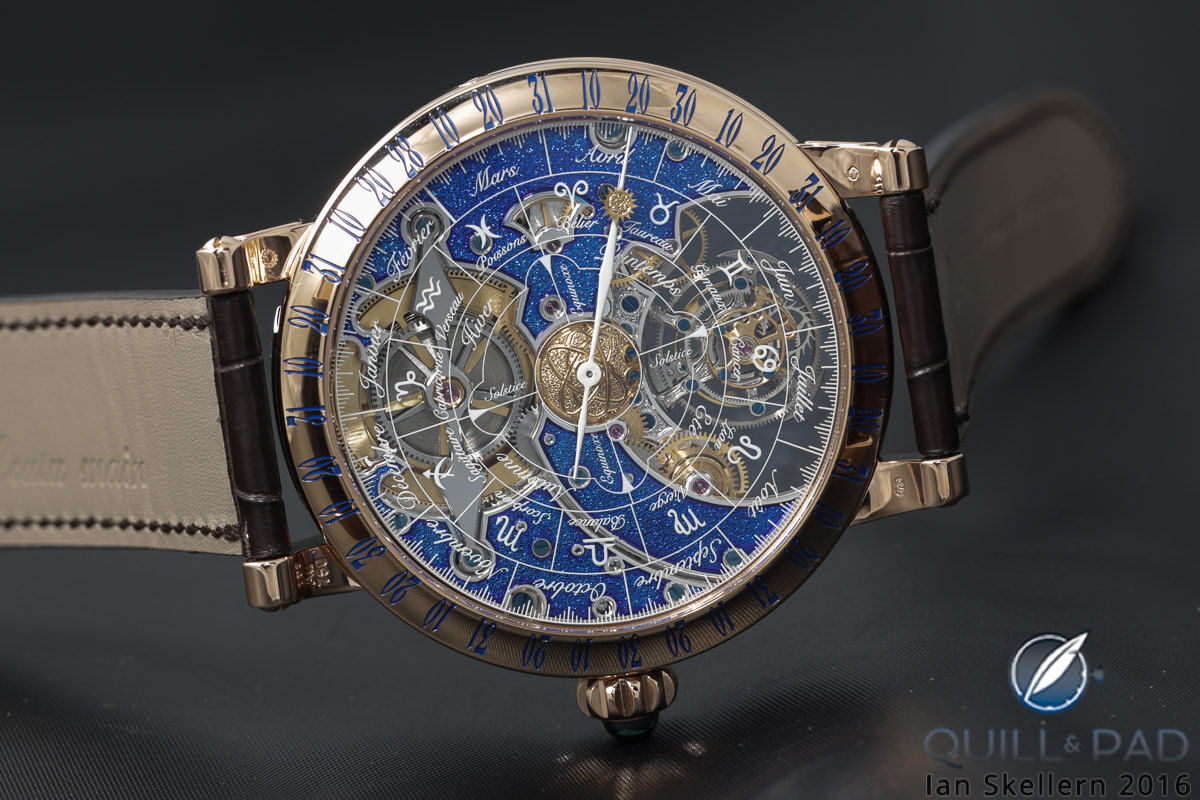
Back of the Bovet Récital 20 Astérium
Used almost across the entire rear of the movement and on many of the plates and bridge on the front of the movement, this chiseled texture adds a lot of contrast to the polished arches, beveled edges, and satinized surfaces.
Given the complexity of the movement it is surprising that 60 pieces were announced. Even considering that’s 60 pieces in total for all variations, it seems a high number for such an outstanding movement and watch. Given that I may go years before seeing another one, just like a solar eclipse or an intense meteor shower the moments I spent with this one are still sharp in my mind.
The variety of indications and the unique display of them makes the Récital 20 Astérium stand out as one of the best pieces from Bovet ever (and that is saying a lot, in my humble opinion).
Even including the chiming pieces, this watch stands proudly as a horology and astronomy nerd’s dream. It focuses on accurate celestial mechanics instead of simply averaging them out like nearly every other watch does. Of course that makes it more difficult to create, but since when did difficulty stop motivated engineers and watchmakers?
The development and creation of the Récital 20 Astérium loudly and clearly highlights that there are still watchmakers who care about how a watch functions and what its purpose is. Such a technical astronomical timepiece is becoming rarer these days, so it is great to see new ways of doing old things developed by a brand. Bovet is constantly intriguing, and this piece doesn’t disappoint.
Now if only I could say the same about meteor showers and bad weather.
I guess I can’t win them all, so how about a breakdown!
- Wowza Factor * 9.95 Space is king right now, and this piece is a lord among lords!
- Late Night Lust Appeal * 102.3 » 1,003.220m/s2 It doesn’t take more than a glimpse or two of this watch to be lusting for hours on end, but closer inspection makes this as powerful as the sun’s gravity!
- M.G.R. * 71.2 This nearly gets a perfect score for movement geekiness, the only thing lacking is something that makes a sound and it would be perfect in its own right!
- Added-Functionitis * Critical It should be fairly obvious that immediate attention is required with this many added functions. You will need emergency strength Gotta-HAVE-That cream for the cosmic swelling inside!
- Ouch Outline * 12.75 Accidents with power tools! Let’s just say that something bad happened recently and an emergency room visit was sadly required. Everything is on the mend now, but I would be highly tempted to do it again (as terrible as it would be) if it meant being the proud owner of this incredible watch!
- Mermaid Moment * The time it takes to set the watch! By the time you are done making sure all the indications are where they need to be, you will have interacted with it so much that the only logical thing to do next walk down the aisle!
- Awesome Total * 820 Multiply the number of pieces (60 total) with the number of different indications (12) and then add the depth rating in feet (100) for a cosmically intense awesome total!
For more information, please visit www.bovet.com/timepiece/dimier-recital-20-asterium.
Quick Facts Bovet Récital 20 Astérium
Case: 46 x 18.3 mm, white gold, red gold, or platinum
Movement: manual winding Caliber 17DM02-SKY
Functions: hours (24-hour display), retrograde minutes, seconds; moon phase, power reserve indicator, equation of time, night sky, annual sidereal calendar, seasons, solstice and equinox indicator, astrological zodiacs indicator
Limitation: 60 pieces across all variations
Price: 335,000 Swiss francs
Leave a Reply
Want to join the discussion?Feel free to contribute!





















































I’m not sure I’d trust myself to wear it. Amazing piece.
Stunning piece of watch making. I would also be afraid to wear it anywhere but my home.
Amazing!
Love the piece! Now to start saving 🙂
It truly is the most incredible watch I’ve ever seen. $335K!!?? Like so many luxury items nowadays, it’s price is absurdly high. Sorry, I just can’t justify that kind of money.
I feel you Alan, I don’t know if many could justify that kind of money. I can’t unless it’s imaginary. But honestly, given the time, effort, and human capital that went into creating something like this, the breakdown of the price actually isn’t too terrible. Consider that the price is paying for a few craftsman and watchmakers yearly salaries, plus the cost of development (which is never cheap). I’m not saying it is affordable, but the cost is much, much more than just the metal, sapphire, and enamel. That’s the truth of pieces like these. Costs of the lower end pieces are amortized over many examples, but these bear the full cost of creation. Thanks for reading!